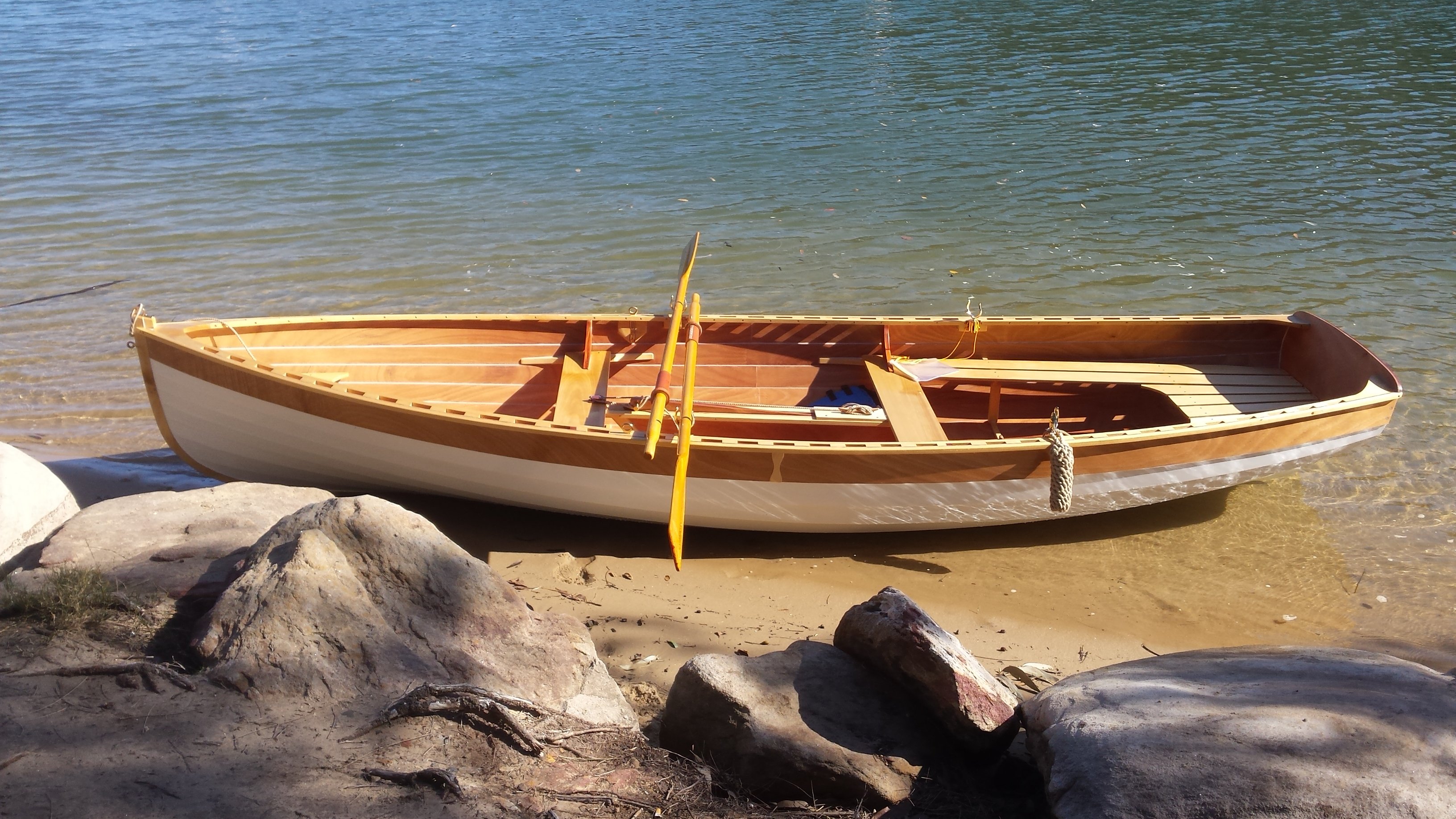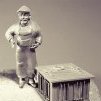Supplies of the Ship Modeler's Handbook are running out. Get your copy NOW before they are gone! Click on photo to order.
×
-
Posts
1,261 -
Joined
-
Last visited
Reputation Activity
-
 Bedford got a reaction from John Allen in Miss Caroline by Bedford - Scale 1:8 - model of my full size build
Bedford got a reaction from John Allen in Miss Caroline by Bedford - Scale 1:8 - model of my full size build
More progress, the exterior of the hull is finished and is ready for paint. I have to work out a way to turn 5mm brass rod into 3mm "D" profile to create the rubbing strips.
-
 Bedford got a reaction from Diver in Miss Caroline by Bedford - Scale 1:8 - model of my full size build
Bedford got a reaction from Diver in Miss Caroline by Bedford - Scale 1:8 - model of my full size build
Well the whisky plank is on, sadly no whisky in the house.
-
 Bedford got a reaction from Retired guy in Miss Caroline by Bedford - Scale 1:8 - model of my full size build
Bedford got a reaction from Retired guy in Miss Caroline by Bedford - Scale 1:8 - model of my full size build
Yeah, the mains'l and jib when it's warm enough to go sailing!
Meanwhile I've now got the model of my boat half planked!
-
 Bedford got a reaction from Retired guy in Miss Caroline by Bedford - Scale 1:8 - model of my full size build
Bedford got a reaction from Retired guy in Miss Caroline by Bedford - Scale 1:8 - model of my full size build
I found that letting the next plank into the previous one at stem and stern required a fine chisel or miniature shoulder plane. Found a plane online but a bit much $$ and a bit big so I made a chisel from a short length of 1/8" HSS tool steel and it works a treat!
Next problem was applying the glue along the length of the plank without it skinning over due to reverse cycle heating, I needed a quicker way to apply it so I made a glue syringe, it's short and fat (the plunger is 10mm diameter) with a 1mm nozzle. The glue goes on very quickly now.
-
 Bedford got a reaction from Retired guy in Miss Caroline by Bedford - Scale 1:8 - model of my full size build
Bedford got a reaction from Retired guy in Miss Caroline by Bedford - Scale 1:8 - model of my full size build
More progress, both garboards, skeg and keel fitted. On the 1:1 the keel was in 2 pieces joined aft of the centre board slot but on the model it's 1 piece from the fore foot to the transom. I will cut the centre board slot on the mill with a 3mm bit.
-
 Bedford got a reaction from Retired guy in Miss Caroline by Bedford - Scale 1:8 - model of my full size build
Bedford got a reaction from Retired guy in Miss Caroline by Bedford - Scale 1:8 - model of my full size build
Greg, the 1:1 molds were stepped to locate each strake and give a flat land on the mold for the strake. The lands between strakes were still planed to give a proper mating surface. So if you took a completed boat and pressed a giant profile gauge into it you'd get the shape of the mold if that makes sense.
The stepped molds just worked as a guide so all the strakes overlapped by the correct amount etc.
It's very hard to replicate at his scale because the ply is only 0.8mm thick so in this case they are more just guide lines to work to.
This pic doesn't show it very well because it's of a concave part of the hull and the next strake did fall flush on the garboard at that mold but was then rebated into the garboard as it flowed to the transom. You can see the step for the third strake and a straight edge placed on that land would hit the edge of the second strake so you remove material from the second strake until the straight edge lays flat on the third strake land and fair it to the next mold etc.
-
 Bedford got a reaction from Retired guy in Miss Caroline by Bedford - Scale 1:8 - model of my full size build
Bedford got a reaction from Retired guy in Miss Caroline by Bedford - Scale 1:8 - model of my full size build
Port garboard is on!
I knew I had drawings of the strakes at a small size to show how they went together. As luck would have it the drawing is at 50% of the build size so I just had to double the size and tweek them a bit to make them fit, well the first one anyway. The ply at 0.8mm is easily cut with good scissors which makes life easy and means I can cut the strakes inside, no sawdust!
-
 Bedford got a reaction from Retired guy in Miss Caroline by Bedford - Scale 1:8 - model of my full size build
Bedford got a reaction from Retired guy in Miss Caroline by Bedford - Scale 1:8 - model of my full size build
A little more done, this time I steam bent the apron while the original is laminated.
I've joined the keelson to the apron and started fairing the keelson to accept the garboards but here I have to stop because I'm waiting on a sheet of 0.8mm plywood from which I'll laminate 2 layers and then a layer of mahogany to make the transom before I can finish fitting and fairing the keelson in preparation for the planking which will be done with the 0.8mm plywood.
-
 Bedford got a reaction from Retired guy in Miss Caroline by Bedford - Scale 1:8 - model of my full size build
Bedford got a reaction from Retired guy in Miss Caroline by Bedford - Scale 1:8 - model of my full size build
Thwarts are cut and floors are in, and the floors were every bit as fiddly as on the real thing!
-
 Bedford reacted to KeithAug in Germania Nova 1911 by KeithAug - FINISHED - Scale 1:36 - replica of schooner Germania 1908
Bedford reacted to KeithAug in Germania Nova 1911 by KeithAug - FINISHED - Scale 1:36 - replica of schooner Germania 1908
I have had a few good days progressing the deck planking. The following photos show a lot of the narrower planks now in place.
I have been drawing pencil lines across the planks as I go as an aid to checking the joggling is symmetrical, fortunately it is.
My joggling tool consists of 2 offcuts of deck planking each with a caulking strip glued to one edge. They are coloured red to stop them getting lost among the other offcuts.
By using the red planks as a gauge I am able to accurately mark the position of the joggles in preparation for cutting out.
I did a bit of sanding to confirm the deck was going to look OK.
I hope to finish the deck planking in the next 2 days.
-
 Bedford reacted to wefalck in SMS WESPE 1876 by wefalck – FINISHED - 1/160 scale - Armored Gunboat of the Imperial German Navy - as first commissioned
Bedford reacted to wefalck in SMS WESPE 1876 by wefalck – FINISHED - 1/160 scale - Armored Gunboat of the Imperial German Navy - as first commissioned
After many trials and tribulations I completed the awnings over the hatch that leads down into the the deckshouse. Such hatches were protected by railings made from polished brass tubes with connectors cast in brass. The railings had sockets into which arched awning stanchions could be fitted. The hole arrangement could be dismantled in order to be able to cover the hatches in very bad weather. The old photograph shows a similar arrangement on an austro-hungarian warship of the same period. The contemporary drawings of SMS WESPE show such quite complex hatch-cover.
Hatch and its cover on board of an austro-hungarian warship of about the same period
I first attempted to turn the stanchions from brass wire or small brass nails, but both materials turned out to be too soft given that they are 5 mm long with a diameter of only 0.3 mm. Even my sophisticated steadies didn’t work. In the end I had to fabricate them from 0.3 mm with 0,5 mm sections of 0.5 diameter brass tube slipped over them. The upper connectors were cross-drilled in the dividing head on my micro-mill for the 0.2 mm horizontals. I also attempted to turn 0.7 mm diameter knobs to fit onto the stanchions using a specially made cutting bit. While they turned out reasonably well, it proved impossible to fit them – I lost them faster than I could make new ones ... the knobs are simulated by tiny blobs of of white glue, painted in brass. Acceptable at normal viewing distance, but pretty awful in close-up photography.
Attempts to provide the stanchions with sockets for the awning-stanchions failed and I simplified the construction by just making a wire-loop at the end, that slips over the stanchions before the knobs were made. The knob in the centre was turned and cross-drilled.
The hatch-coaming was fabricated from two layers of bakelite so that it would rest on the deck. The corners were drilled 0.3 mm for the stanchions.
Assembly proved a major challenge for my patience and took me several evenings. Luckily, SMS WESPE has only one such hatch cover. The whole structure was assembled using lacquer. It would have been better to solder it, but I wanted to keep the polished brass appearance – nothing looks more like metal, well, then metal ! Nevertheless, I have some very good metallic paint made by a Czech company (http://www.agama-color.cz/en/products/colours) that was used on the knobs.
The model representation. The hatch is 7 mm x 11 mm – close-up photographs are unforgiving
To be continued soon(?) ...
-
 Bedford reacted to KeithAug in Germania Nova 1911 by KeithAug - FINISHED - Scale 1:36 - replica of schooner Germania 1908
Bedford reacted to KeithAug in Germania Nova 1911 by KeithAug - FINISHED - Scale 1:36 - replica of schooner Germania 1908
Hello Tom - my drum sander lacks sophistication I'm afraid. I use the drum and sanding tubes from an oscillating sander. The sanding table is made from 3/8 inch ply below which is a dust collection box connected to a vacuum port.
Sanding is done between the upstanding wooden plank and the sanding drum. The plank pivots on the pin at the far end and coarse adjustment is made by the screw on the left hand side.
The hole in the table is about 1/4 inch bigger in diameter than the sanding drum which means that I can fine tune the thickness of the sanded components by adjusting the table relative to the drum axis using the Y axis of the mill table. This works very well and allows me to achieve very accurate results.. The table clamps in the jaws of the milling vice and hence is quickly removed and replaced.
Peter thank you for visiting, my methods are probably a result of my antiquity.
Pat - thank you - pity about the Ashes!!!!!!!!!!!
Eberhard - thank you .
-
 Bedford reacted to BANYAN in Germania Nova 1911 by KeithAug - FINISHED - Scale 1:36 - replica of schooner Germania 1908
Bedford reacted to BANYAN in Germania Nova 1911 by KeithAug - FINISHED - Scale 1:36 - replica of schooner Germania 1908
Hi Keith, when I was over there recently I warned a friend that it would be a close series this time, I don't think he believed me. Now had we only found a way to 'hobble' Broad and Stokes ????? At least the Ashes stayed in their rightful possession
cheers, and back to the modelling table with tail between legs.
cheers
Pat
-
 Bedford got a reaction from Retired guy in Miss Caroline by Bedford - Scale 1:8 - model of my full size build
Bedford got a reaction from Retired guy in Miss Caroline by Bedford - Scale 1:8 - model of my full size build
I've been a bit busy with other things lately but I've finally spent a little time on the lathe and made the handle for the centreboard, the original full size one was much easier!
-
 Bedford reacted to KeithAug in Germania Nova 1911 by KeithAug - FINISHED - Scale 1:36 - replica of schooner Germania 1908
Bedford reacted to KeithAug in Germania Nova 1911 by KeithAug - FINISHED - Scale 1:36 - replica of schooner Germania 1908
I made a start on the deck planking. As previously explained the deck has 2 widths of plank. The wider planks will be .216" x .060" x 12 inch - at full scale this equates to planks 7.75" wide by 36 foot long. The narrower planks will be .125' x .060" x 12 inch - at full scale 4.5" wide by 36 foot long.
I did a hunt through the shed to find a light shade of wood to represent a faded teak deck (which I think is what Germania has - see image in previous post). I came up with some old wooden kitchen doors so I thought I would give them a try.
They seem to cut reasonably well, have a close grain and uniform colouration. They do feel unpleasantly fibrous when cut but sand well. The wood is quite soft and easy to cut with hand tools and doesn't seem to splinter. I haven't a clue what the wood might be.
Once I had cut the slices from the door I passed them all through my improvised milling machine drum sander. As a result the widths were all within a couple of thou of the target plank widths.
Planks of the correct thickness (.060") were then cut from the slices. The margin planks are only .050" thick and the extra .010" of thickness on the deck planks is to give me ample scope for sanding.
I am caulking between the planks with .006" thick black card. The card is good quality to avoid fibres impregnating the wood during sanding.
I cut the caulking strips from the card on the mill. I use a metal rod in the chuck to act as the backstop for the square and advance the table in .060" increments to produce caulking strips of the correct width.
Having completed the margin planks I guessed what the bow and stern finish looked like. Both are under gratings and not visible in any of the photos. I shouldn't worry really as they wont be visible on the finished model. I have completed 8 of the 10 wider planks. As yet I have not needed to start joggling the stern planks.
At the bow end joggling has commenced and so far is turning out pretty uniform.
I am finding that cutting the joggle in the margin plank is made much easier by first drilling with a very fine drill (.020") in the corner of the piece to be removed. I then cut the short butt end with a sharp craft knife and finally cut the long edge with a single press of a vertically held 1 inch wide chisel. This seems to avoid any splintering of the margin plank. I then mark out the deck plank to fit the joggle and cut it with a vertically held chisel. With a bit of care this seems to produce and accurate result.
I have just started the final (9th and 10th) wide planks. The narrower planks should slow my progress somewhat.
-
 Bedford got a reaction from Retired guy in Miss Caroline by Bedford - Scale 1:8 - model of my full size build
Bedford got a reaction from Retired guy in Miss Caroline by Bedford - Scale 1:8 - model of my full size build
Well the whisky plank is on, sadly no whisky in the house.
-
 Bedford got a reaction from aviaamator in Miss Caroline by Bedford - Scale 1:8 - model of my full size build
Bedford got a reaction from aviaamator in Miss Caroline by Bedford - Scale 1:8 - model of my full size build
Yeah, the mains'l and jib when it's warm enough to go sailing!
Meanwhile I've now got the model of my boat half planked!
-
 Bedford got a reaction from kees de mol in Miss Caroline by Bedford - Scale 1:8 - model of my full size build
Bedford got a reaction from kees de mol in Miss Caroline by Bedford - Scale 1:8 - model of my full size build
I found that letting the next plank into the previous one at stem and stern required a fine chisel or miniature shoulder plane. Found a plane online but a bit much $$ and a bit big so I made a chisel from a short length of 1/8" HSS tool steel and it works a treat!
Next problem was applying the glue along the length of the plank without it skinning over due to reverse cycle heating, I needed a quicker way to apply it so I made a glue syringe, it's short and fat (the plunger is 10mm diameter) with a 1mm nozzle. The glue goes on very quickly now.
-
 Bedford got a reaction from kees de mol in Miss Caroline by Bedford - Scale 1:8 - model of my full size build
Bedford got a reaction from kees de mol in Miss Caroline by Bedford - Scale 1:8 - model of my full size build
More progress, both garboards, skeg and keel fitted. On the 1:1 the keel was in 2 pieces joined aft of the centre board slot but on the model it's 1 piece from the fore foot to the transom. I will cut the centre board slot on the mill with a 3mm bit.
-
 Bedford got a reaction from kees de mol in Miss Caroline by Bedford - Scale 1:8 - model of my full size build
Bedford got a reaction from kees de mol in Miss Caroline by Bedford - Scale 1:8 - model of my full size build
Greg, the 1:1 molds were stepped to locate each strake and give a flat land on the mold for the strake. The lands between strakes were still planed to give a proper mating surface. So if you took a completed boat and pressed a giant profile gauge into it you'd get the shape of the mold if that makes sense.
The stepped molds just worked as a guide so all the strakes overlapped by the correct amount etc.
It's very hard to replicate at his scale because the ply is only 0.8mm thick so in this case they are more just guide lines to work to.
This pic doesn't show it very well because it's of a concave part of the hull and the next strake did fall flush on the garboard at that mold but was then rebated into the garboard as it flowed to the transom. You can see the step for the third strake and a straight edge placed on that land would hit the edge of the second strake so you remove material from the second strake until the straight edge lays flat on the third strake land and fair it to the next mold etc.
-
 Bedford got a reaction from KeithAug in Miss Caroline by Bedford - Scale 1:8 - model of my full size build
Bedford got a reaction from KeithAug in Miss Caroline by Bedford - Scale 1:8 - model of my full size build
Port garboard is on!
I knew I had drawings of the strakes at a small size to show how they went together. As luck would have it the drawing is at 50% of the build size so I just had to double the size and tweek them a bit to make them fit, well the first one anyway. The ply at 0.8mm is easily cut with good scissors which makes life easy and means I can cut the strakes inside, no sawdust!
-
 Bedford got a reaction from Retired guy in Miss Caroline by Bedford - Scale 1:8 - model of my full size build
Bedford got a reaction from Retired guy in Miss Caroline by Bedford - Scale 1:8 - model of my full size build
Now that I have the molds sorted I've been able to attach the transom and the keelson is now glued to the transom with the same strengthening knee I decided to add to the full size boat.
-
 Bedford got a reaction from Retired guy in Miss Caroline by Bedford - Scale 1:8 - model of my full size build
Bedford got a reaction from Retired guy in Miss Caroline by Bedford - Scale 1:8 - model of my full size build
I had a set back with this project. I'm guessing that the heating inside caused the building "spine" to warp a bit so everything went out of whack. I walked away from it for a while!
Hopefully the problem is now solved by using different materials and approach. Everything is now clamped and aligned very nicely.. Rather than removing the molds to add glue and re-position them I will cut several small blocks and just glue them into the right angles in the jig so it all stays aligned.
-
 Bedford got a reaction from aviaamator in Miss Caroline by Bedford - Scale 1:8 - model of my full size build
Bedford got a reaction from aviaamator in Miss Caroline by Bedford - Scale 1:8 - model of my full size build
A little more done, this time I steam bent the apron while the original is laminated.
I've joined the keelson to the apron and started fairing the keelson to accept the garboards but here I have to stop because I'm waiting on a sheet of 0.8mm plywood from which I'll laminate 2 layers and then a layer of mahogany to make the transom before I can finish fitting and fairing the keelson in preparation for the planking which will be done with the 0.8mm plywood.
-
 Bedford got a reaction from Retired guy in Miss Caroline by Bedford - Scale 1:8 - model of my full size build
Bedford got a reaction from Retired guy in Miss Caroline by Bedford - Scale 1:8 - model of my full size build
Popeye, thanks for the compliment.
I am building her again exactly (almost) the way I built the original. The building form shown is a 1/8th scale representation of the original and will be scrapped once the hull is finished and righted for fit out. Each individual plank land is cut into the molds to aid correct fitment. I even have a sheet of 0.8mm plywood on order for the planks.






